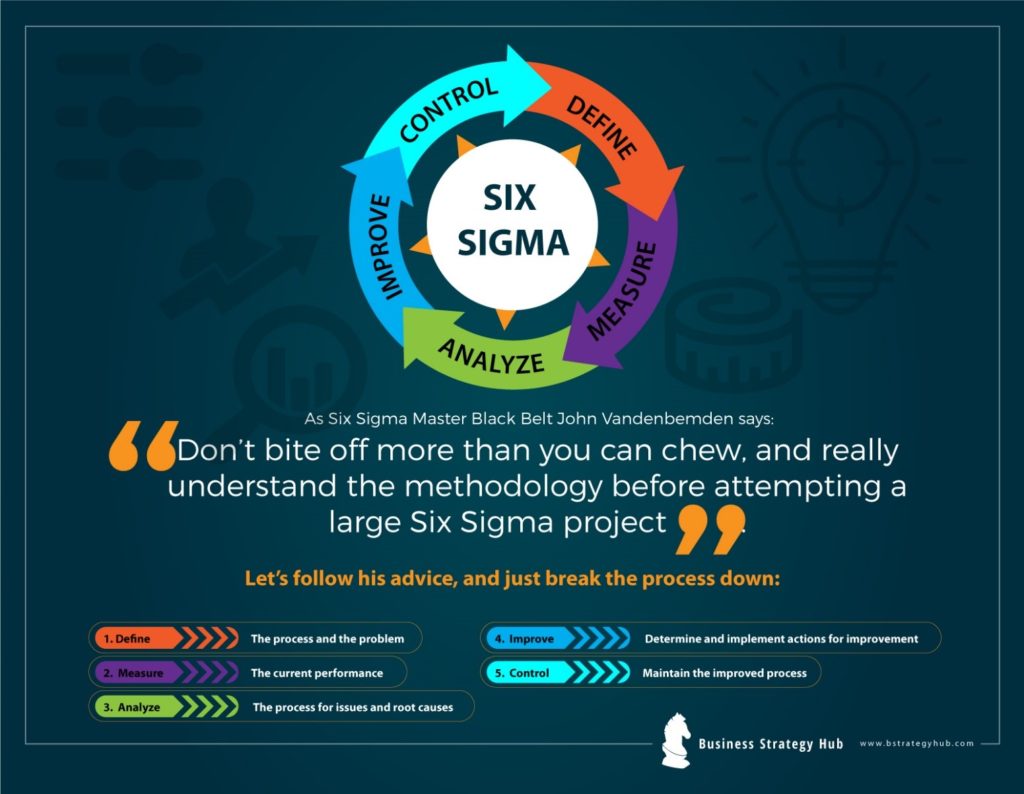Model Name: Six Sigma
Author: Bill Smith
Year: 1986
Purpose: Process improvement| production quality improvement | measuring and eliminating defects in manufacturing & development | increasing efficiency | improve customer satisfaction | ensure compliance | standardize business development
As a business owner, you would naturally want to expand and grow your business. But, as overridden as this next statement may sound, growing your business is not something to be taken lightly. It comes with its challenges and demands.
No, this doesn’t mean that you should stop thinking about boosting your business! It only means that you should take an organized and well-thought-out approach.
So how do you get your business to grow successfully? What kind of approach would ensure an optimized business performance?
You would want to expand your target market, increase your customer base, and be more efficient overall to be on the course to business growth. Isn’t that so?
If this is what you are aiming for, you need the Six Sigma framework. While there are countless other approaches and tools, and there is also no shortage of business growth strategies, but the Six Sigma framework is one of the best for this purpose.
What is Six Sigma?
Six Sigma is a proven methodology and a powerful framework for improvement of quality and elimination of defects in any business operations process. Introduced by Engineer Bill Smith in 1980s while he was working at Motorola, Six Sigma became popular when General Electric made it a part of their business strategy.
When can you use it?
If we put it simply, you can use Six Sigma for business growth and process improvement.
It focuses on the elimination of defective products, reduction of waste, and fixing of inefficient services. It can even help in empowering employees and increasing customer satisfaction. All these aspects are considered vital for quality improvement, increasing customer base, and consequently, prove essential for any business to grow and prosper.
So, what actually constitutes the Six Sigma methodology?
Within Six Sigma, there are well-defined methods and procedures for guiding projects. Basically, the figure below actually sums up the basics of this methodology.

As you can see, the DMIAC (Define, Measure, Analyze, Improve and Control) is the essence of Six Sigma.
These steps form the fundamental pillars of any process improvement initiative, and so they are also central to Six Sigma.
How can you use Six Sigma?
Want to know how can you use Six Sigma? Here are the questions to ask at each stage and understand how you can use Six Sigma for process improvement and business growth.
Define
This stage is all about defining the process or the problem. Consider asking these questions at this stage of the Six Sigma method:
- What do we want to do?
- What exactly is the problem?
- How is it affecting or impeding the growth of my organization?
When you define the problem, consider all relevant aspects. At this stage, a brainstorming session is very useful.
Example:
A car wash company was seeing a drop in its customer base and ultimately faced some loss in revenue. How can this company start improving their business and begin their journey to growth using Six Sigma?
Well, they will have to initiate the process by defining their problem. Gathering and recording data by means of surveys, customer complaints, interviews, or internal feedback might do the trick at this stage.
Measure
What next? Now that you have defined the problem or the process you need to work on, the next step is to measure the data. Collect all the relevant statistics and gather all the information that can be used for finding a solution. Questions such as these might help:
- Where am I today?
- What are my current processes?
- How much are they beneficial?
- Where do I want to be in the future?
- What statistics are related to the problem?
- Do these statistics help in understanding the problem?
Example:
Let’s continue with the example of the car wash company, at this stage, the team would gather and measure data. For e.g. they will find out when exactly the number of customers began to drop, what are the marketing initiatives taken by the company, was there any change in the internal processes or any external market changes that may have impacted, how are the services as compared to the competitors, etc.
Analyze
This analyze phase can be seen as the heart of Six Sigma as it helps in determining the problem’s root cause. It is mainly about finding the ‘why’ of things.
Ask these questions when in the analyze phase of Six Sigma:
- Why is this happening?
- Why do we address this issue?
- Why this method would work?
Only when the root cause is identified in an accurate manner, a feasible solution can be found.
Example:
After measuring, the car wash company team begins to analyze the root cause of the problem. The correlation and regression method reveals that it was in October that client base started dropping. Further brainstorming reveals that it was because the lighting system was not appropriate. Hence, in the evening hours, potential clients would not be able to see the company.
Improve
This is a stage that can be a little trickier. Here we need some possible solutions. Out of them, the one that is the best in terms of financials, organization’s values, a goal that is to be achieved, etc. is chosen. Trials, experiments, pilot tests, anything you want to call them, are carried out to check if the solution works.
Consider asking these questions in the improve stage:
- What are the possible solutions to this problem?
- Will this solution bring more ROI?
- Is this solution better in terms of financials?
- Will it help to achieve the goal?
Control
Now that you have made the improvement needed, you do not want the problem to reoccur, right? The control stage is for that same purpose. This is a stage that sets Six Sigma apart from other methods. It is actually to prevent re-occurrence. So ask these questions:
- How can we focus on continuous improvement?
- What will prevent re-occurrence of this issue?
- How much will it benefit in the long-term?
- What tools or process will be needed for improving this process continuously?
Limitations
What business owner doesn’t want to constantly improve their operations processes and accomplish tasks in better and faster ways? No doubt, Six Sigma is popular for this purpose.
However, it has some limitations. You need to remember that it is not a one-size-fits-all kind of a solution. Also, according to research, the management and employees, active customer participation, and active supplier participation may cause hurdles in the successful implementation of Six Sigma.
Final Thoughts
Finally, it is important to keep in mind that whether you use Six Sigma or any other process improvement strategy, the results may not be immediate. It is a long-term effort, and regular commitment is the key.
The idea behind the use of this method is to fix root causes that may hinder business growth. If deployed in the right manner, and if made a regular part of the culture of your organization, Six Sigma will become part of the DNA of your company. Soon enough, growth and greater profits are sure to follow.
Tell us what you think? Did you find this article interesting?
Share your thoughts and experiences in the comments section below.












Add comment